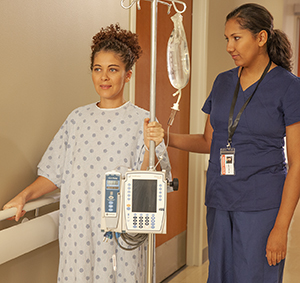A
B
C
D
E
F
G
H
I
J
K
L
M
N
O
P
Q
R
S
T
U
V
W
X
Y
Z
Topic IndexLibrary Index
Click a letter to see a list of conditions beginning with that letter.
Click 'Topic Index' to return to the index for the current topic.
Click 'Library Index' to return to the listing of all topics.
After an Appendectomy
Most people recover quickly after an appendectomy. You may be in the hospital for 1 to 2 days. You may stay longer if your appendix burst. After you get home, plan a follow-up visit with your healthcare provider in 1 to 2 weeks, or as advised.
In the hospital
In most cases, you'll drink liquids and walk on the day of the surgery. You'll be given pain medicine. You may be taught breathing exercises. These are to help keep your lungs clear. You may have a drain in place. This is a small tube that comes through the cut (incision) in your belly. It will likely be taken out before you leave the hospital. You may be given medicines to prevent constipation.
 |
| You will start walking very soon after surgery. Walking helps you recover faster and helps prevent complications. |
Back at home
Take your medicines as directed. They can help control pain from the surgery. Don't do any tough activity or heavy lifting. Don't drive until your surgeon says it's OK. Slowly go back to your normal activities in 7 to 10 days. Keep taking medicines or fiber as advised to prevent constipation. Check your incision as directed by your healthcare team.
When to call your healthcare provider
Call your healthcare provider if you have any of these:
-
Swelling, oozing, or pain that gets worse
-
Redness near the incision that gets worse
-
A fever of 100.4°F (38°C) or higher, or as advised by your provider
-
Belly pain that gets worse
-
Severe diarrhea, bloating, or constipation
-
Upset stomach (nausea) or vomiting
-
Swelling or pain in your legs
Call 911
Call 911 right away if you have trouble breathing.
Online Medical Reviewer:
Heather M Trevino BSN RNC
Online Medical Reviewer:
Robyn Zercher FNP
Online Medical Reviewer:
Ronald Karlin MD
Date Last Reviewed:
4/1/2024
© 2000-2025 The StayWell Company, LLC. All rights reserved. This information is not intended as a substitute for professional medical care. Always follow your healthcare professional's instructions.